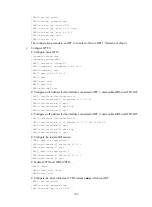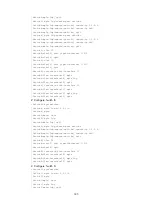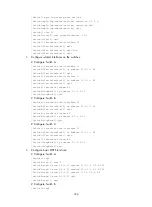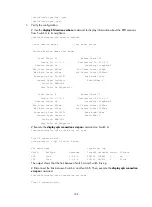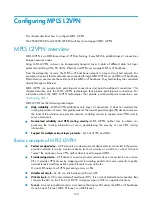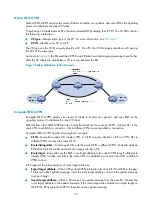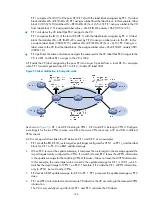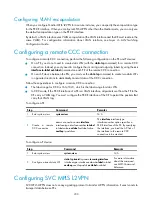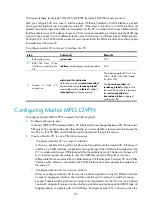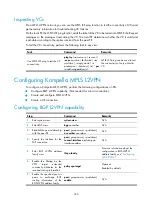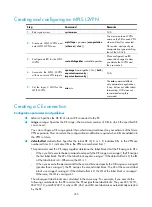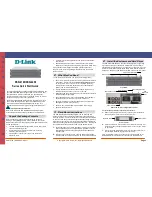
195
In a word, route target attributes define which PEs can receive L2VPN information, and from which PEs
that a PE can receive L2VPN information.
Different from Martini mode, the Kompella mode does not distribute the VC label assigned by the local
PE directly to the peer PE through the signaling protocol. Instead, it uses label blocks to assign labels to
multiple connections at a time. A PE advertises label blocks to all PEs in the same VPN. Each PE calculates
the VC labels according to the label blocks from other PEs.
A label block includes the following parameters:
•
Label Base
—Initial label value of the label block. A PE automatically selects the LB value that cannot
be manually modified.
•
Label Range
—Number of labels that the label block contains. LB and LR determine the labels
contained in the label block. For example, if the LB is 1000 and LR is 5, the label block contains
labels 1000 through 1004.
•
Label-block Offset
—Offset of the label block. When CEs increase in a VPN and the existing label
block size is not enough, you do not need to withdraw the label block on the PEs. Instead, you can
assign a new label block in addition to the existing label block to enlarge the label range. A PE uses
LO to identify a label block among all label blocks, and to determine from which label block it
assigns labels. The LO value of a label block is the sum of LRs of all previously assigned label blocks.
For example, if the LR and LO of the first label block is 10 and 0, the LO of the second label block
is 10. If the LR of the second label block is 20, the LO of the third label block is 30.
The following describes a label block in the format of LB/LO/LR. For example, a label block whose LB,
LO, and LR are 1000, 10, and 5 is represented as 1000/10/5.
With label blocks, you can reserve some labels for the VPN for future use. This wastes some label
resources in a short term, but can reduce the VPN deployment and configuration workload in the case
of expansion.
Assume that an enterprise VPN contains 10 CEs and the number of CEs may increase to 20 in future. In
this case, set the LR to 20. When you add a CE to the VPN, you only need to modify the configurations
of the PE to which the new CE is connected. No change is required for the other PEs, which simplifies
VPN expansion.
Figure 51
VC label calculation
As shown in
, PEs calculates VC labels for a VC as follows (take the VC between CE 1 and CE
12 as an example):
•
PE 1 calculates the VC label it assigns to the VC:
VPN 1
CE 1
CE 2
PE 1
PE 2
P
VPN 1
VPN 1
Label block 1: 1000/0/5
Label block 2: 1055/5/10
CE 12
Label block for CE 2: 2000/0/15
Label block for CE 12: 3000/0/15
VC connected CE 1 and CE 2:
local VC label: 1002
remote VC label: 2001
VC connected CE 1 and CE 12:
local VC label: 1062
remote VC label: 3001
VC connected CE 1 and CE 2:
local VC label: 2001
remote VC label: 1002
VC connected CE 1 and CE 12:
local VC label: 3001
remote VC label: 1062
Label block allocated
Label block allocated
VC labels calculated



